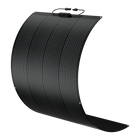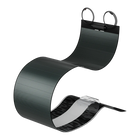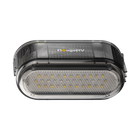What is Monocrystalline Solar Panel?

Solar power is one of the cleanest, safest, and most efficient energy sources available today. It is a renewable energy source that can be used as a primary or secondary source of energy. It does not cause any harmful CO2 emissions into the atmosphere, nor does it create any hazardous waste. The use of solar energy has been increasing steadily over the last few years.
As per the United States Department of Energy, the amount of solar energy produced in the United States reached 97.2 GW till now. This is enough to provide electricity for approximately 18 million average households.
The technology behind solar energy is called photovoltaic (PV) cells that convert the sun's rays into electrical energy, including monocrystalline solar cells, polycrystalline, and thin-film solar cells. Here we'll discuss the most popular Monocrystalline solar panels, let's unveil the hidden mysteries behind them.

What is Monocrystalline Solar Cell Technology?
A monocrystalline solar cell is a type of solar cell that uses a single crystal of silicon as its semiconductor material. This type of solar cell has the highest efficiency in converting light into electricity.
Solar panels made out of monocrystalline silicon are the best option for those who want to produce the maximum amount of energy per square foot. These panels are also known as mono-cells because they consist of one large piece of silicon. Polycrystalline solar panels, in the contrast, contain multiple crystals of silicon. They can be cheaper to make than mono-cell panels, but they do not produce as much energy.
Construction and Working Principle of Monocrystalline panel
The monocrystalline solar panels are manufactured using the Czochralsky method, with each PV module produced from a single crystal of high purity silicon. The silicon is heated, crystallized into ingot shapes, and sliced into thin wafers. These wafers are then mounted in a grid pattern to form a single unit, it provides a high level of precision and accurate results.
Photons are emitted from the sun, these photons interact with the monocrystalline silicon solar cells to produce electrons and holes. This is usually known as the photoelectric effect. Electrons movement produces an electric current which produces DC power which is utilized directly by DC-powered devices or by using a DC to AC inverter.
The panel's top surface is gently diffused with phosphorous which helps to create an orientation that is electrically negative as compared to the bottom which has a positive electrical orientation, which leads to the creation of the electric field. For maximum absorption and reduced reflection of sunlight, the cells' surface is coated with silicon nitride (Si3N4). Finally, the produced electricity is collected via metal conductors pinned onto these cells.
Power and Performance
The energy yield of a solar panel refers to how much power it produces over its lifetime. A solar panel's energy yield is measured in watts per square meter (W/m²). Monocrystalline solar panels have a higher energy yield than polycrystalline panels and other counterparts. This is because the monocrystalline silicon absorbs more light and converts it into electricity more efficiently. This ability takes the performance of mono panels to next level.
Advancements in Monocrystalline solar panels
PERC (passivated emitter and rear contact cell)
PERC is a brand name for a specific type of solar panel technology. These panels are manufactured using an additional passivation layer on the back side of the silicon wafers. The passivation layer prevents the electrons from escaping from the silicon substrate. As a result, these cells have higher efficiency than traditional mono-crystalline cells. PERCs are now produced by leading solar brands and are appreciated throughout the US. They offer the following benefits:
- Boosted performance even in minimum-light and high-temperature conditions.
- The higher energy density per square foot than conventional monocrystalline cells.
- The superior anti-reflective coating absorbs more light resulting in more efficiency.
Bifacial solar panels
In a bifacial paneled system, the extra light which normally gets lost in traditional mono facial panels can be absorbed again by the panel. In such an instance, where the light hits a highly reflective surface, it reflects the sunlight towards the panel, to be transformed into more electricity hence more energy generation. By exposing both sides of the panels to sunlight, bifacial panelized systems can produce more power.
The monocrystalline panel's cost is truly justified
The average cost for mono panels ranges from $1 to $1.5 per watt, slightly higher than polycrystalline $0.7 to $1 per watt. The hefty price tag is due to the complex manufacturing process of extracting pure silicon crystals for maximum efficiency.
The higher cost is justified by performance and generated kilowatts (kW). The solar system is a one-time investment hence despite the initial cost, mono panels wouldn’t disappoint you in quality, durability, and optimal performance. Premium panels cost a bit but deliver hassle-free service for generations. Faster ROI and supreme efficiency force worldwide energy experts to recommend installing mono panels for a successful solar project.
Key metrics of Monocrystalline solar panels
a. Unmatched efficiency of Monocrystalline solar panels
In recent years, monocrystalline solar panels are becoming increasingly popular for residential use, especially in countries where electricity prices are high. These panels have a much higher conversion rate than polycrystalline panels, meaning they produce more electricity per watt of input power. They have the highest efficiency rate (15-22 percent) because they are made out of high-purity rating silicon.
b. Appealing Aesthetics and Durability/Lifespan of Monocrystalline solar panels
Monocrystalline solar panels are built with an appealing look and last longer than polycrystalline panels. Polycrystalline panels tend to get dirty over time and lose their aesthetic appeal. Monocrystalline panels don't need cleaning as often as polycrystalline panels do. Monocrystalline panel lifespan is up to 25 years while polycrystalline panels only last 10-15 years.
Monocrystalline solar panels are the best bet for residential and commercial applications due to their high durability and longer lifespan.
c. Temperature Coefficient of Monocrystalline solar panels
The temperature of your PV panel and the energy generation are mutually connected exactly as per laws of thermodynamics and how heat limits any electronics’ ability to generate power.
The temperature coefficient of most monocrystalline solar panels ranges -0.3% / °C to -0.5% / °C. It expresses that for every 1°C above 25°C, efficiency falls off by 0.37%.
Some great applications of Monocrystalline solar panels
a. Best for hotter climates
Monocrystalline Solar Panels are the best choice for hot climates like Arizona, Hawaii, and California. These panels have been designed to harness the sun's rays at their peak efficiency. They are capable of producing up to 40% more electricity than conventional polycrystalline panels.
b. Ideal for large-scale solar system installations, such as commercial and residential.
Mono Solar Panels are ideal for large-scale solar systems due to their high efficiency and maximum output. These panels have been used in many different types of solar power systems including small rooftop systems, utility-scale projects, and even large-scale ground-mounted systems.
c. Small monocrystalline solar panels kits are used in camping, outdoor
Small monocrystalline solar panel kits are used in camping and outdoor activities for an off-grid experience. You can use them to charge small electronic devices like phones, laptops, cameras, GPS units, and MP3 players. Now planning your next trip in an RV with a portable monocrystalline solar panel kit is the solution to all your energy needs.
d. Monocrystalline solar panels are best suited for smaller roof area
The monocrystalline solar panel is the best choice for small roofs. It's economical concerning energy generation and high efficiency is achieved without occupying a lot of space. These panels can easily be installed on apartments, condos, and other buildings and give you optimal performance. We can say, they are smaller in size but super solid in performance.
Available ratings of Monocrystalline solar panels
The current market is full of various solar panel sizes and a ready-made solution for all your energy needs. The panel’s rating is strongly connected with energy demand. For a small home, or a trip for RV a few 120W or 180W Monocrystalline panels are sufficient. However, to power your entire house with solar you’ll surely need panels of higher ratings like 300W, 400W, and 600W.
Final Thoughts
If you're conscious about getting the most out of your system, it's worth spending your money on top-quality materials and components. When choosing panels, look for a company that has a good reputation and can give you full customer support.
To get the real return on your investment, bougerv.com is the one-stop solution offering you industry-leading trusted brands and SUPER efficient Tier 1 Monocrystalline solar panels tailored to your needs. Our High-level 9BB Cell Design has a 22.8% Highest Conversion rate which guarantees peak performance and Top-notch efficiency. Our vast product range includes fixed, foldable, and portable solar kits which never let your power down in any situation. Choose wisely and be satisfied!







































